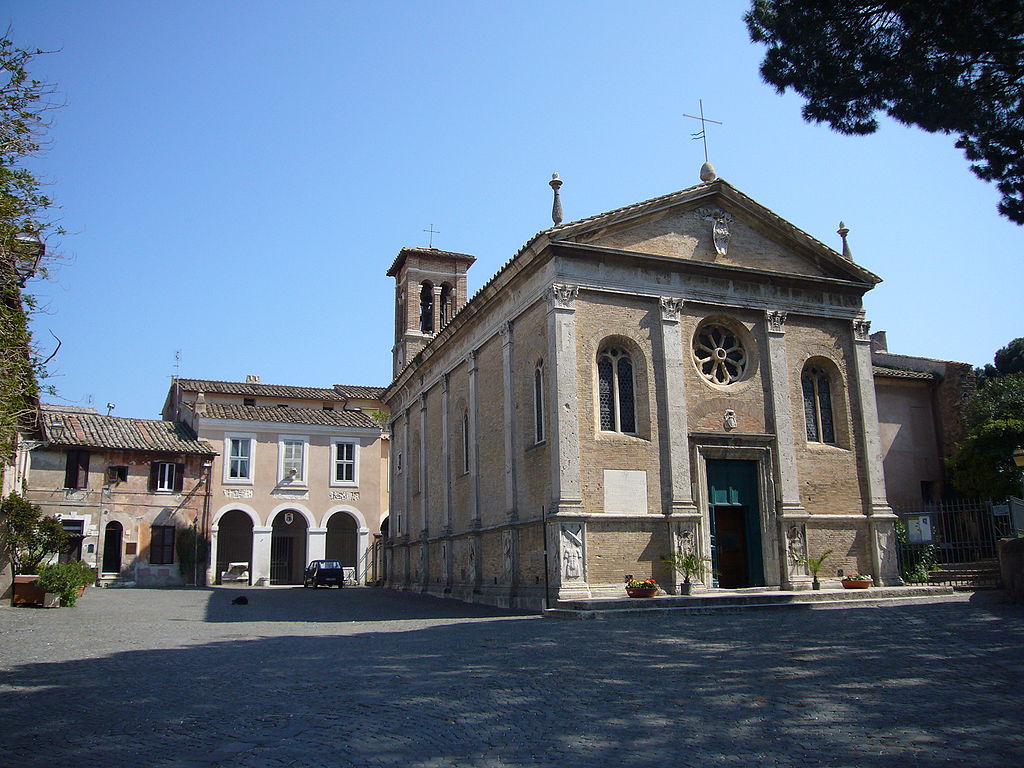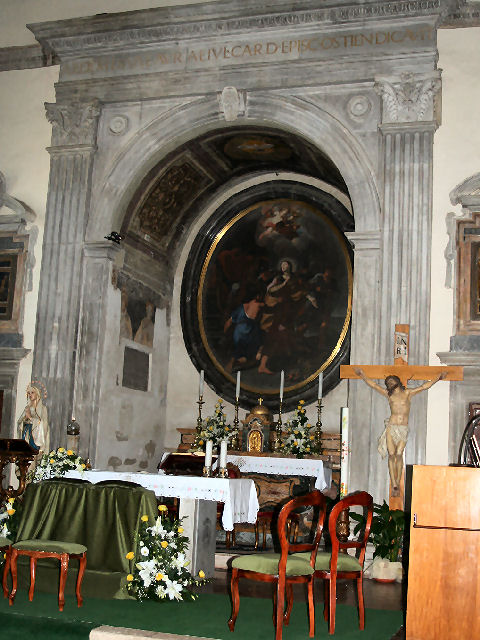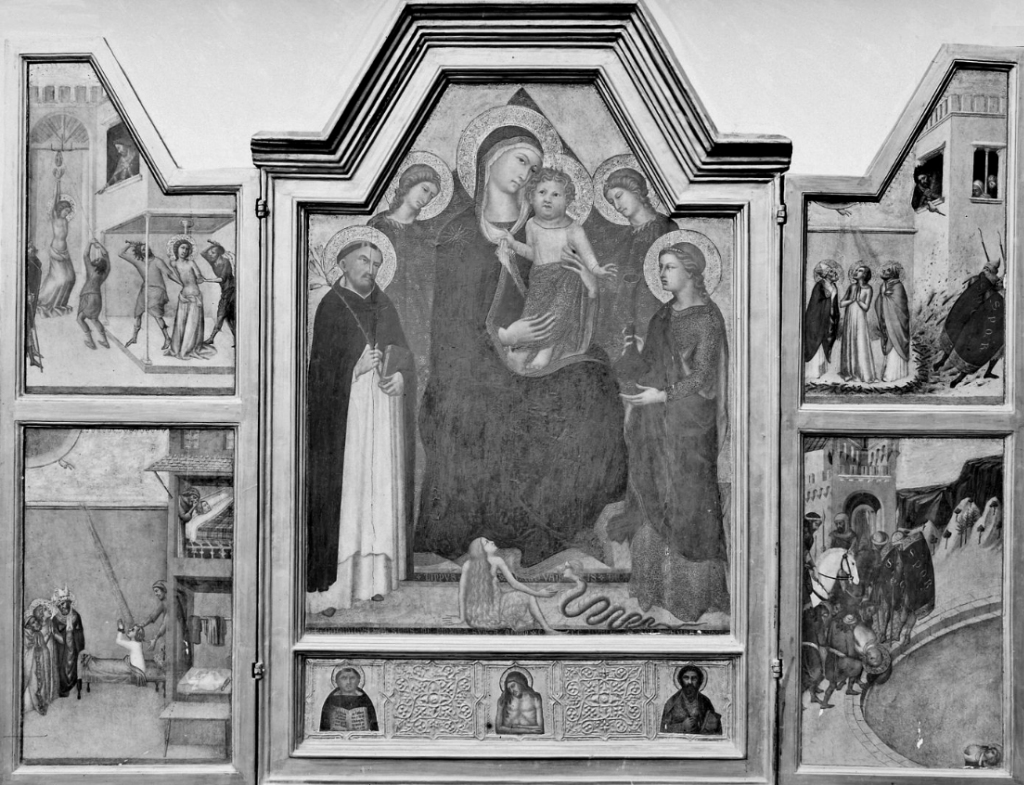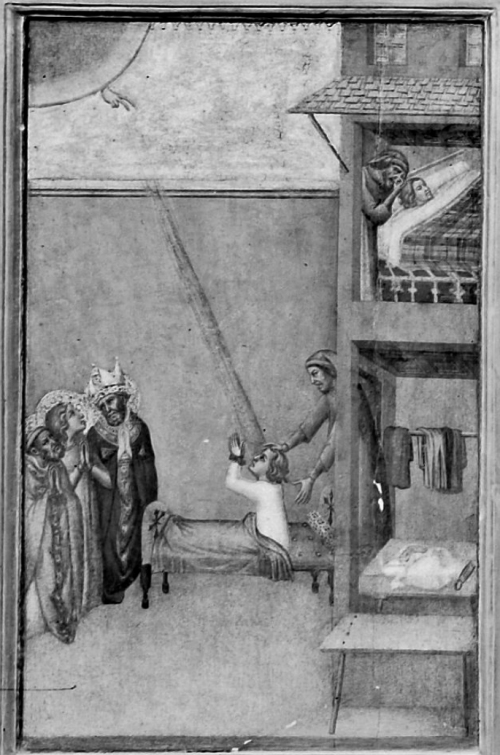Church of Sant'Aurea
In the centre of the mediaeval borgo of Ostia Antica is the church of Aurea. This was a Christian girl, who was executed in the later third century during the reign of Claudius Gothicus (268-270 AD) or perhaps Trebonianus Gallus (251-253 AD) (see the Acta Martyrum ad Ostia Tiberina). Apparently she belonged to the family of a Roman Emperor. Because of her religious conviction she had been sent away from Rome to Ostia, where she lived on her own estate, called Euparisti, outside the city walls. She was in touch with the Ostian bishop, Cyriacus, and other Christian church officials. Later another Christian, Censorinus, was emprisoned in Ostia (perhaps criminals were often sent to Ostia and put to work in the harbour). Aurea and others comforted him, and one day his chains were miraculously loosened, a miracle leading to the conversion of 17 soldiers. The Christian company also brought the dead son of a shoemaker back to life. Aurea's companions were executed by a high official from Rome, Ulpius Romulus. The soldiers were beheaded near the Arch of Caracalla in front of the theatre. Aurea was tortured, but refused to sacrifice to the pagan gods. She was then thrown in the sea with a stone tied to her neck. She was buried on her own property and here the church was built.
In 1981 a fragment of a Christian inscription was found near the church:
| CHRYSE HIC DORM[IT] | Chryse is sleeping here. |
Chryse, "golden girl", is Greek for Aurea. In the church a plaster cast of the inscription can be seen. It may be her original funerary inscription, but it may also have been added later to the tomb.
Another inscription, perhaps from the fifth century, was found near the church in 1950. It is on a small marble column that can today be seen near the altar:
| S(ancta) AVR(ea) |
In 387 AD the mother of Augustinus, Monica, died and was buried in Ostia. Her funerary epitaph was found near the church in 1945. The text was made by Anicius Bassus, a later consul. It was already known from ancient manuscripts. The orginal inscription can today be seen inside the church:
|
HIC POSVIT CINERES GENETRIX CASTISSIMA PROLIS AVGVSTINE TVI(s) ALTERA LUX MERITI(s) QVI SERVANS PACIS CAELESTIA IVRA SACERDOS COMMISSOS POPVLOS MORIBVS INSTITVIS GLORIA VOS MAIOR GESTORVM LAVDE CORONAT VIRTVTVM MATER FELICIOR SVBOLE |
Here the most virtuous mother of a young man set her ashes a second light to your merits, Augustine. As a priest, serving the heavenly laws of peace, you taught [or, you teach] the people entrusted to you with your character. A glory greater than the praise of your accomplishments crowns you both Mother of the Virtues, more fortunate because of her offspring. (translation: Douglas Boin) |
Remains of the oldest church of Aurea have been investigated on various occasions after the Second World War, next to and below the present church. The orientation was precisely the opposite of that of the present church. The building consisted of three naves with an apse behind the central one. In the floor and around the church graves for inhumation were found (formae). For the brick-and-tufa masonry of the walls (opus vittatum) several parallels are found in Ostia: the large apse in the Hall of the Group of Mars and Venus (II,IX,3), the nymphaeum in the House of Cupid and Psyche (I,XIV,5), and the nymphaeum in the House of the Nymphaeum (III,VI,1-3), dated to c. 325-350 AD. Such a date is allowed by the type of tombs. It is probably not a coincidence that Monica was buried near Aurea. This suggests that the church existed already in 387 AD.
A procession with the statue of Saint Aurea, leaving her church in the borgo.
Filmed on May 27 2023 by Jan Theo Bakker.
The church was renovated around 700 AD by pope Sergius I, because it was in a bad condition (distecta vel disrupta). New repairs were carried out around 800 AD by Leo III. The Liber Pontificalis describes a mass in the church in 849 AD, held by pope Leo IV in relation to a naval battle near Ostia between Muslim pirates and an Italian league. The battle is famous because of its depiction on a fresco from the workshop of Raphael, in the Vatican.
The seat of the bishop (episcopium) is behind the church. The church was an episcopal church (of the bishop) from at least the late 12th century, but perhaps from an earlier date, taking over this role from the Constantinian church in region V. The latter church stopped functioning around 800 AD.
In 1479 cardinal d'Estouteville ordered the building of the church that we see today. The work was finished under cardinal Giuliano della Rovere. The architect was Baccio Pontelli. A large painting of the martyrdom in the apse of the church was made in the 17th century by Andrea Sacchi. In 1430 however the relics of the martyr had been removed from the urn and taken to Rome, together with those of Monica, by pope Martinus V (Acta Sanctorum, May 1, p. 490). They were placed in the Basilica di Sant'Agostino in Campo Marzio (to the north-east of Piazza Navona). Here a strigilated sarcophagus with a statue of the deceased Monica can today be seen. Later still, in 1736, the remains of Aurea were brought to Albano Laziale (near Castel Gandolfo), to the chapel of the order of the "Suore Oblate di Gesù e Maria". They were returned to her Ostian church in 2013.
Scenes from the martyrdom are depicted on a triptych in Santi Domenico e Sisto in Rome, behind the Forum of Trajan (see: Anne Dunlop, "The Dominicans and Cloistered Women: The Convent of Sant'Aurea in Rome", Early Modern Women 2 (2007), 43-71). They were made by Lippo Vanni, a painter from Siena, in 1358. In the central panel we see the Virgin with the Child, in front of two angels. To her left is Dominicus, founder of the Dominican order, to her right Aurea (at the bottom is the text SCA AVRA). Below the Virgin are Eve and the snake, below that Christ, flanked by the apostle Bartholomaeus and Thomas of Aquino (Bartholomaeus and Aurea share the same feast day: August 24). On the side panels four scenes from the martyrdom of Aurea are depicted.
The triptych was meant for the convent of Sant'Aurea in Campo Senese, first recorded in 1348, and situated near Campo dei Fiori. The convent was later replaced by the church of Spirito Santo dei Napoletani. All that remains of the convent is the name of a street in Rome: Via di Sant'Aurea. The painting was brought to its current location in 1575. Other depictions of Aurea are a triptych by Duccio, now in the National Gallery in London, a triptych in the Walters Art Gallery in Baltimore, and a painting in the Dominican church of Gubbio (near Perugia).
















